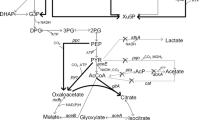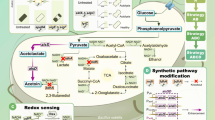Abstract
It is of great economic interest to produce succinate from low-grade carbon sources, e.g., lignocellulosic biomass hydrolysate, which mainly contains glucose and xylose. Inactivation of the glucose uptake system PtsG was evaluated for succinate production from xylose-rich feedstocks. Strains with integration of succinate production modules into the chromosome of Escherichia coli were then constructed. These strains have better succinate production performance from xylose-rich feedstocks than strain FZ560 harboring pHL413KF1. Glucose utilization was enhanced in FZ661T by manipulation of the gal operon to allow efficient use of the high-concentration glucose in woody biomass hydrolysate. Up to 906.7 mM (107.0 g/L) succinate was produced from mixed sugars in fed-batch fermentation and more than 461.7 mM (54.5 g/L) succinate was produced from woody hydrolysate in a batch fermentation. In this study, FZ661T was able to produce succinate from woody hydrolysate in minimal medium efficiently, making it attractive for industrial applications in succinate production.





Similar content being viewed by others
References
Ahn JH, Jang Y-S, Lee SY (2016) Production of succinic acid by metabolically engineered microorganisms. Curr Opin Biotechnol 42:54–66
Ahn JH, Jang Y-S, Yup Lee S (2017) Succinic acid. In: Wittmann C, Liao JC (eds) Industrial biotechnology: products and processes, 1st edn. Wiley-VCH Verlag GmbH & Co. KGaA, New York, pp 505–544. https://doi.org/10.1002/9783527807833.ch17
Balzer GJ, Thakker C, Bennett GN, San K-Y (2013) Metabolic engineering of Escherichia coli to minimize byproduct formate and improving succinate productivity through increasing NADH availability by heterologous expression of NAD + -dependent formate dehydrogenase. Metab Eng 20:1–8
Blankschien MD, Clomburg JM, Gonzalez R (2010) Metabolic engineering of Escherichia coli for the production of succinate from glycerol. Metab Eng 12:409–419
Bozell JJ, Petersen GR (2010) Technology development for the production of biobased products from biorefinery carbohydrates—the US Department of Energy’s “top 10” revisited. Green Chem 12:539–554
Bradfield MF, Mohagheghi A, Salvachúa D, Smith H, Black BA, Dowe N, Beckham GT, Nicol W (2015) Continuous succinic acid production by Actinobacillus succinogenes on xylose-enriched hydrolysate. Biotechnol Biofuels 8:181
Chen P, Tao S, Zheng P (2016) Efficient and repeated production of succinic acid by turning sugarcane bagasse into sugar and support. Bioresour Technol 211:406–413
Gírio FM, Fonseca C, Carvalheiro F, Duarte LC, Marques S, Bogel-Łukasik R (2010) Hemicelluloses for fuel ethanol: a review. Bioresour Technol 101:4775–4800
Görke B, Stülke J (2008) Carbon catabolite repression in bacteria: many ways to make the most out of nutrients. Nat Rev Microbiol 6:613–624
Gosset G (2005) Improvement of Escherichia coli production strains by modification of the phosphoenolpyruvate: sugar phosphotransferase system. Microb Cell Factories 4:14
Hernández-Montalvo V, Martínez A, Hernández-Chavez G, Bolivar F, Valle F, Gosset G (2003) Expression of galP and glk in a Escherichia coli PTS mutant restores glucose transport and increases glycolytic flux to fermentation products. Biotechnol Bioeng 83:687–694
Huang B, Yang H, Fang G, Zhang X, Wu H, Li Z, Ye Q (2018) Central pathway engineering for enhanced succinate biosynthesis from acetate in Escherichia coli. Biotechnol Bioeng 115:943–954
Humbird D, Davis R, Tao L, Kinchin C, Hsu D, Aden A, Schoen P, Lukas J, Olthof B, Worley M (2011) Process design and economics for biochemical conversion of lignocellulosic biomass to ethanol: dilute-acid pretreatment and enzymatic hydrolysis of corn stover. National Renewable Energy Lab (NREL), Golden
Jiang M, Ma J, Wu M, Liu R, Liang L, Xin F, Zhang W, Jia H, Dong W (2017) Progress of succinic acid production from renewable resources: metabolic and fermentative strategies. Bioresour Technol 245:1710–1717
Jiang Y, Chen B, Duan C, Sun B, Yang J, Yang S (2015) Multigene editing in the Escherichia coli genome via the CRISPR-Cas9 system. Appl Environ Microbiol 81:2506–2514
Keasling JD (1999) Gene-expression tools for the metabolic engineering of bacteria. Trends Biotechnol 17:452–460
Lee P, Lee S, Hong S, Chang H, Park S (2003) Biological conversion of wood hydrolysate to succinic acid by Anaerobiospirillum succiniciproducens. Biotechnol Lett 25:111–114
Li Q, Huang B, He Q, Lu J, Li X, Li Z, Wu H, Ye Q (2018) Production of succinate from simply purified crude glycerol by engineered Escherichia coli using two-stage fermentation. Bioresour Bioprocess 5:41
Li Y, Huang B, Wu H, Li Z, Ye Q, Zhang YP (2016) Production of succinate from acetate by metabolically engineered Escherichia coli. ACS Synth Biol 5:1299–1307
Loman AA, Ju L-K (2017) Enzyme-based processing of soybean carbohydrate: recent developments and future prospects. Enzyme Microb Technol 106:35–47
Lu J, Tang J, Liu Y, Zhu X, Zhang T, Zhang X (2012) Combinatorial modulation of galP and glk gene expression for improved alternative glucose utilization. Appl Microbiol Biotechnol 93:2455–2462
Martinez A, Grabar TB, Shanmugam KT, Yomano LP, York SW, Ingram LO (2007) Low salt medium for lactate and ethanol production by recombinant Escherichia coli B. Biotechnol Lett 29:397–404. https://doi.org/10.1007/s10529-006-9252-y
McKinlay JB, Vieille C, Zeikus JG (2007) Prospects for a bio-based succinate industry. Appl Microbiol Biotechnol 76:727–740
Sievert C, Nieves LM, Panyon LA, Loeffler T, Morris C, Cartwright RA, Wang X (2017) Experimental evolution reveals an effective avenue to release catabolite repression via mutations in XylR. Proc Natl Acad Sci 114:7349–7354. https://doi.org/10.1073/pnas.1700345114
Song H, Lee SY (2006) Production of succinic acid by bacterial fermentation. Enzyme Microb Technol 39:352–361
St-Pierre F, Cui L, Priest DG, Endy D, Dodd IB, Shearwin KE (2013) One-step cloning and chromosomal integration of DNA. ACS Synth Biol 2:537–541
Steinsiek S, Bettenbrock K (2012) Glucose transport in Escherichia coli mutant strains with defects in sugar transport systems. J Bacteriol 194:5897–5908
Thakker C, Martínez I, San KY, Bennett GN (2012) Succinate production in Escherichia coli. Biotechnol J 7:213–224
Thakker C, San K-Y, Bennett GN (2013) Production of succinic acid by engineered E. coli strains using soybean carbohydrates as feedstock under aerobic fermentation conditions. Bioresour Technol 130:398–405
Tyo KE, Ajikumar PK, Stephanopoulos G (2009) Stabilized gene duplication enables long-term selection-free heterologous pathway expression. Nat Biotechnol 27:760
Werpy T, Petersen G, Aden A, Bozell J, Holladay J, White J, Manheim A, Eliot D, Lasure L, Jones S (2004) Top value added chemicals from biomass: volume-I—Results of screening for potential candidates from sugars and synthesis gas. National Renewable Energy Lab, Golden
Wu H, Lee J, Karanjikar M, San K-Y (2014) Efficient free fatty acid production from woody biomass hydrolysate using metabolically engineered Escherichia coli. Bioresour Technol 169:119–125
Zhu F, Lu L, Fu S, Zhong X, Hu M, Deng Z, Liu T (2015) Targeted engineering and scale up of lycopene overproduction in Escherichia coli. Process Biochem 50:341–346
Zhu F, Wang Y, San KY, Bennett GN (2018) Metabolic engineering of Escherichia coli to produce succinate from soybean hydrolysate under anaerobic conditions. Biotechnol Bioeng 115:1743–1754
Acknowledgements
This work was supported by United Soybean Board Award #1840-352-0707-C.
Author information
Authors and Affiliations
Corresponding author
Additional information
Publisher's Note
Springer Nature remains neutral with regard to jurisdictional claims in published maps and institutional affiliations.
Rights and permissions
About this article
Cite this article
Zhu, F., Wang, C., San, KY. et al. Metabolic engineering of Escherichia coli to produce succinate from woody hydrolysate under anaerobic conditions. J Ind Microbiol Biotechnol 47, 223–232 (2020). https://doi.org/10.1007/s10295-020-02259-7
Received:
Accepted:
Published:
Issue Date:
DOI: https://doi.org/10.1007/s10295-020-02259-7




